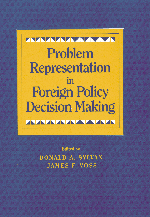Book contents
- Frontmatter
- Contents
- List of Contributors
- Part I Introducing Problem Representation
- Part II Overarching Conceptual Issues
- Part III Empirical Analysis
- 7 Problem Representations and Political Expertise: Evidence from “Think Aloud” Protocols of South African Elite
- 8 Reasoning and Problem Representation in Foreign Policy: Groups, Individuals, and Stories
- 9 Representing Problem Representation
- 10 A Problem-Solving Perspective on Decision-Making Processes and Political Strategies in Committees: The Case of Controversial Supreme Court Justice Nomination Hearings
- 11 When Gender Goes to Combat: The Impact of Representations in Collective Decision Making
- 12 Representations of the Gulf Crisis as Derived from the U.S. Senate Debate
- 13 Configuring Issue Areas: Belgian and Dutch Representations of the Role of Foreign Assistance in Foreign Policy
- Part IV Conclusion
- Index
10 - A Problem-Solving Perspective on Decision-Making Processes and Political Strategies in Committees: The Case of Controversial Supreme Court Justice Nomination Hearings
from Part III - Empirical Analysis
Published online by Cambridge University Press: 12 October 2018
- Frontmatter
- Contents
- List of Contributors
- Part I Introducing Problem Representation
- Part II Overarching Conceptual Issues
- Part III Empirical Analysis
- 7 Problem Representations and Political Expertise: Evidence from “Think Aloud” Protocols of South African Elite
- 8 Reasoning and Problem Representation in Foreign Policy: Groups, Individuals, and Stories
- 9 Representing Problem Representation
- 10 A Problem-Solving Perspective on Decision-Making Processes and Political Strategies in Committees: The Case of Controversial Supreme Court Justice Nomination Hearings
- 11 When Gender Goes to Combat: The Impact of Representations in Collective Decision Making
- 12 Representations of the Gulf Crisis as Derived from the U.S. Senate Debate
- 13 Configuring Issue Areas: Belgian and Dutch Representations of the Role of Foreign Assistance in Foreign Policy
- Part IV Conclusion
- Index
Summary
In group decision settings, differences in how individuals represent problems may produce barriers to reaching consensus because the wayan individual represents a problem may in large part determine the solutions or decision alternatives one considers (Newell and Simon 1972; see also Voss, Purkitt, and Breuning, all in this volume). Examples of this can be found in highlevel government group decision-making units. A classic example is from the executive committee during the Cuban missile crisis.
McNamara argued that the Soviet missiles did not fundamentally alter the strategic balance. The implication was thus that the US should either do nothing or restrict itself to diplomatic pressure on the Soviets.
Bundy and Nitze argued that missiles in Cuba almost doubled Soviet Strategic power and reduced the warning time in the case of nuclear confrontation from twenty to two minutes. The implication was that the United States had to do its utmost to bring about a swift removal of the missiles. (Maoz 1990: 90)
Other examples on which this chapter focuses can be found in Senate Judiciary Committee decision making in controversial Supreme Court justice nomination hearings. These nominations are characterized by significant differences in individual problem representations at the hearing and lack of consensus in whether to support the nomination. Although this decision context differs in content from others discussed in this volume (i.e., it does not concern foreign policy), it does not differ significantly from these and other aspects of decision making that may be observed in more international domains. In this chapter, the process of the Senate Judiciary Committee's decision making in controversial Supreme Court justice nomination hearings is analyzed from a problem-solving perspective to illustrate how this perspective provides a framework for understanding decision making and how its processes relate to decision outcome and political strategies employed.
Before beginning the specific analysis of decision making in controversial Supreme Court justice nomination hearings, a brief review of various aspects of problem solving in general is undertaken.
Problem Solving
When solving a problem, one first determines a problem space (Simon 1978). Knowledge that is relevant to solving the problem, as well as goals of the problem and imposed constraints, is included in the problem space. For example, the goal in solving a crossword puzzle is to fill in all the blanks with words that correspond to the given clues.
- Type
- Chapter
- Information
- Problem Representation in Foreign Policy Decision-Making , pp. 249 - 260Publisher: Cambridge University PressPrint publication year: 1998



